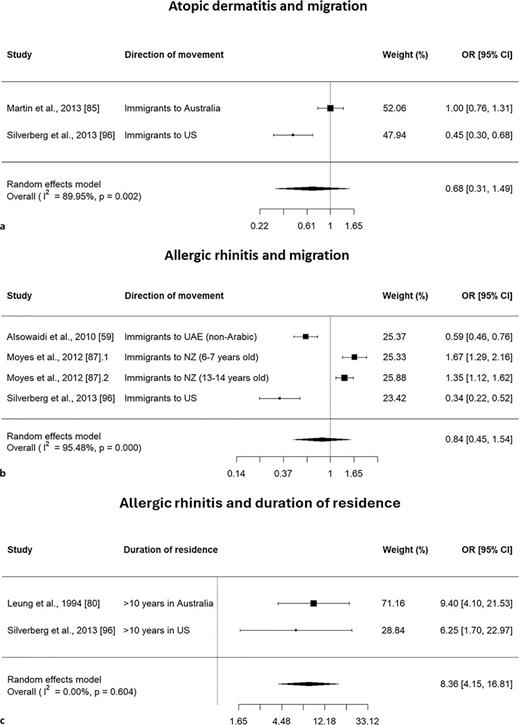Abstract
Introduction: Allergic diseases remain of concern due to their increasing prevalence worldwide. Intrinsic and environmental risk factors have been implicated in the pathogenesis of allergic disease. Among the possible risk factors, migration has been associated with the manifestation of allergic diseases. We aimed to consolidate the existing evidence, review the hypotheses for the relationship between environmental factors and allergic disease, and provide a direction for future work. Methods: This systematic review and meta-analysis complied with Preferred Reporting Items for Systematic Reviews and Meta-Analyses (PRISMA) guidelines. The Web of Science database was searched in September 2023 to retrieve publications investigating the relationship between allergic rhinitis (AR), atopic dermatitis (AD), or asthma and the following factors: (i) migrant status (i.e., migrants vs. natives) or (ii) duration since migration among migrants. Risk of bias was assessed using the JBI critical appraisal tool. Details and findings from the included studies were also summarized and meta-analyses were conducted where appropriate. Results: Fifty studies encompassing an estimated 3,755,248 individuals were reviewed. Articles investigated asthma (n = 46), AR (n = 16), and AD (n = 14). A variety of migration-related factors were also studied: movement of individuals across regions (n = 40), duration since immigration (n = 12), age at immigration (n = 9), and acculturation (n = 2). Migration status was not significantly associated with AD (pooled odds ratio [pOR] = 0.68, 95% confidence interval (CI) = 0.31, 1.49). Although AR prevalence was lower among immigrants than natives (pOR = 0.58, 95% CI = 0.45, 0.74), immigrants who had resided at least 10 years in the destination country had a higher risk of AR than immigrants with a duration of residence of less than 10 years (pOR = 8.36, 95% CI = 4.15, 16.81). Being an immigrant was also associated with a decreased risk of asthma (pOR = 0.56, 95% CI = 0.44, 0.72). Among immigrants, residing in the host country for at least 10 years was associated with increased asthma manifestation (pOR = 1.85, 95% CI = 1.25, 2.73). Immigrants who migrated aged 5 and below did not exhibit a significantly higher likelihood of asthma than migrants who immigrated older than 5 years (pOR = 1.01, 95% CI = 0.68, 1.50). Conclusion: This review was limited by the primarily cross-sectional nature of the included studies. Objective diagnoses of allergic disease, such as using the spirometry of bronchodilator reversibility test for asthma rather than questionnaire responses, could add to the reliability of the outcomes. Furthermore, immigrant groups were mostly nonspecific, with little distinction between their country of origin. Overall, migration appears to be a protective factor for allergic diseases, but the protection subsides over time and the prevalence of allergic diseases among the immigrant group approaches that of the host population.


No comments:
Post a Comment